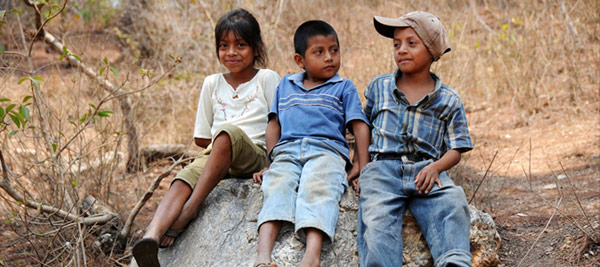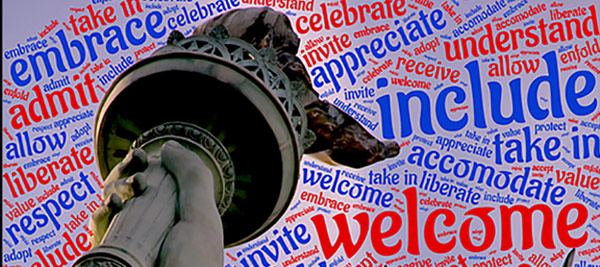Immigration Policy Solutions: Supporting Child Migrants
Many Americans are frustrated with our immigration policies. But research and experience show that it’s not enough to focus only on the problems with our current approach. We also need to paint a picture of what the country would look like with workable, commonsense policies in place. This document discusses policies regarding unaccompanied child migrants and children coming with their families, and solutions so that we treat them in a manner consistent with human rights and due process.
Topline Message:
Our communities should act with care and compassion toward unaccompanied child migrants who have increasingly arrived at the border after fleeing violence and poverty in their home countries, and are attempting to reunify with their families. Unfortunately, our government has responded to this serious refugee situation by substantially increasing family detention and putting children on a fast-track deportation process without legal representation. This is a grave injustice and does not reflect our national values. Instead, we should implement policies that preserve children’s domestic and international human rights protections, particularly when they are in detention; provide them with legal representation; improve community support by providing case management services to all children upon reunification; and address the driving factors that push children that make a perilous journey.
Solutions
Renew Our Commitment to International Human Rights Norms
What the Department of Homeland Security (DHS) Should Do:
- Ensure that every accompanied and unaccompanied child from contiguous countries such as Mexico is screened by licensed child welfare professionals to ensure appropriate care while in detention and adequate screening for immigration relief. Refrain from interviewing children from non-contiguous countries such as El Salvador, Guatemala, or Honduras who will be screened by licensed child welfare professionals in the custody of the Office of Refugee Resettlement. Current screening practices should also be improved so that child survivors of trafficking and persecution are effectively identified, referred for appropriate services, and when appropriate agents assist with trafficking certification.
- Clarify DHS standards for prosecutorial discretion to recognize that children are eligible for a favorable exercise of that discretion, especially when deportation is against the child’s best interests. Prosecutorial discretion for all children should trump a child’s categorization as an enforcement priority if they have recently crossed the border.
- End the use of family detention and utilize a range of alternatives, including placing families in community-based case management services or licensed child welfare programs that support the least restrictive form of custody, safety, and access to legal services.
- Ensure that children and other people in vulnerable situations are not exploited or abused in short-term or long-term custody. This includes creating greater oversight and accountability to prevent shackling, handcuffing, inhumane detention conditions, inadequate access to medical care, and verbal, physical, and sexual abuse by implementing public, enforceable standards for all DHS detention facilities. Customs and Border Protection (CBP) should implement an access policy for civil society to allow for regular oversight and monitoring of its facilities. DHS should place child welfare professionals to oversee the care and custody of all children in CBP custody.
What Department of Justice Should Do:
- Exempt children from the expedited removal process and ensure that children can consult with legal services before accepting voluntary return.
What Congress Should Do:
- Require that the “best interests of the child” be “a primary consideration” in all procedures, actions, and decisions made by a federal agency or court re: unaccompanied children and principal child applicants.
- In asylum cases, base the definition of “membership in a particular social group” on the immutable characteristics test first used in Matter of Acosta, 19 I&N Dec. 211 (BIA 1985).
Ensure that Child Migrants Receive Adequate Representation
What Congress Should Do:
- Mandate the appointment of legal counsel for all children in removal proceedings, including a mix of private pro bono representation and direct representation by appointed lawyers.
- Establish a national legal service program to provide children with information about their legal rights and conduct individual legal assessments.
- Permit immigration judges the discretion to appoint an independent child advocate when necessary.
Encourage Safe and Legal Migration
What the Administration Should Do:
- Allow parents who have Temporary Protected Status (TPS) to apply for derivative TPS for their children.
- Expedite applications under the Central American Minors (CAM) Refugee/Parole Program.
- Broaden access to the CAM Program by allowing parents without legal status to sponsor children and permitting children with viable refugee claims who do not have a parent in the United States to apply.
- Use executive authority to permit a larger number of unaccompanied children into the United States as refugees and expand the use of humanitarian parole to include children fleeing harm and/or reuniting with family.
- End support of interdiction policies that deny children the opportunity to seek protection.
Address the Driving Factors for Migration
What the Administration and Congress Should Do:
- Invest in community-based and comprehensive youth violence prevention strategies.
- Make assistance to police and military conditional on compliance with basic human rights standards, particularly in El Salvador, Guatemala, Honduras, and Mexico, and use this leverage to reduce corruption and dissuade “mano dura” policies (zero-tolerance criminal law policies that violate human rights).
- Strengthen the regional systems of protection for children and migrants in Central America and Mexico, particularly in child welfare, asylum, humanitarian visa, and anti-trafficking.
- End economic agreements and policies that displace people and fail to uphold human and labor rights.
- Sign, adopt, and ratify the International Convention on the Protection of All Migrant Workers and Their Families and the Convention on the Rights of the Child.
Talking Points
- We should act with care and compassion toward children fleeing persecution and harm.
- How we treat child migrants should reflect our national values of due process and human rights.
The research cited in this document is current as of June 2015.



